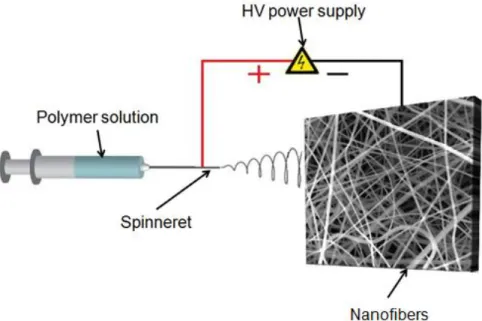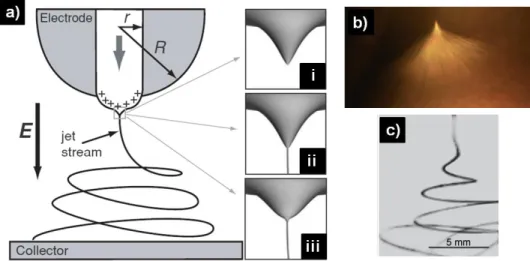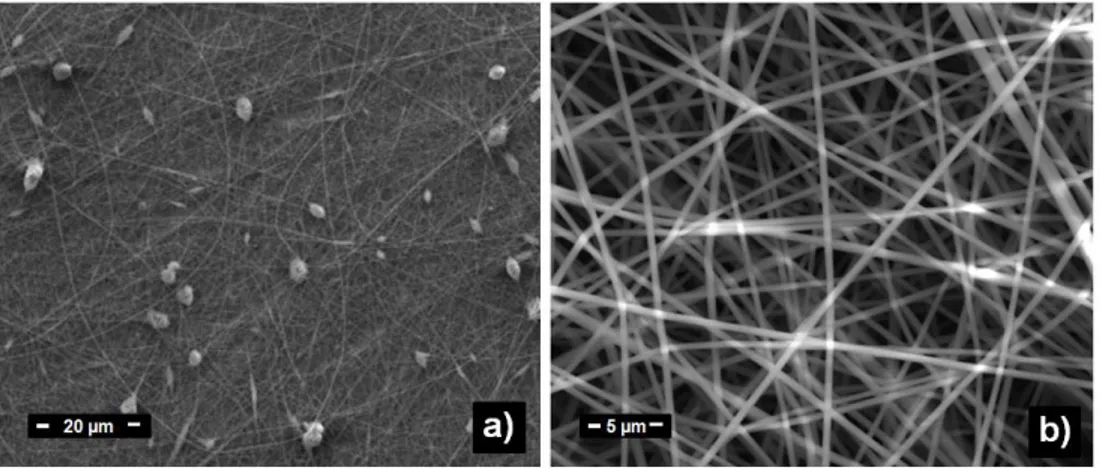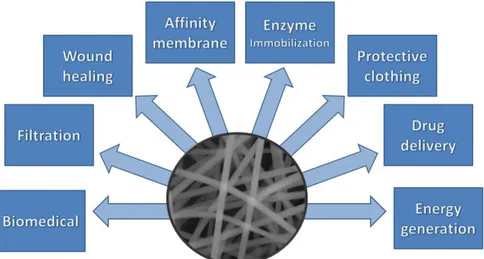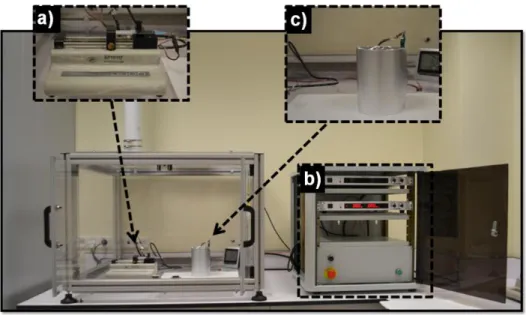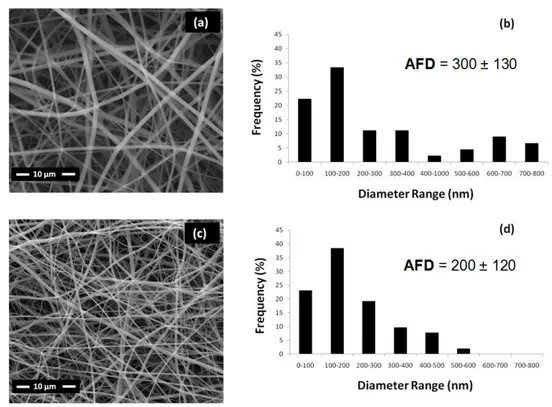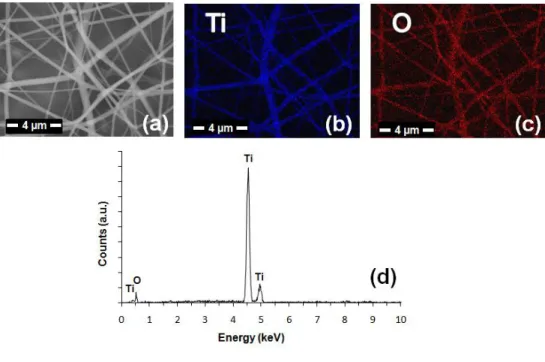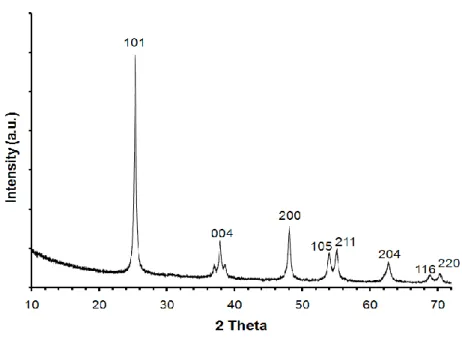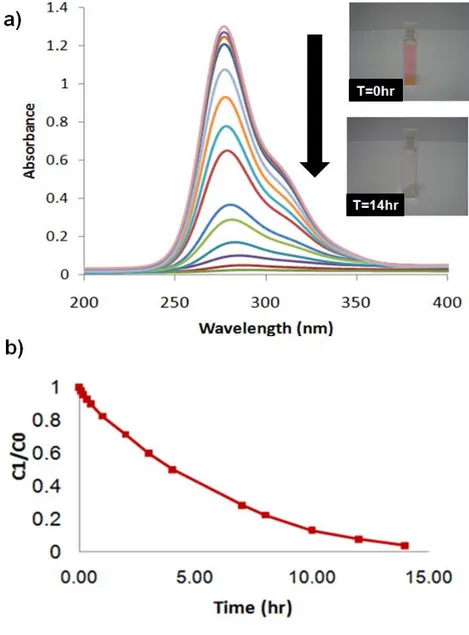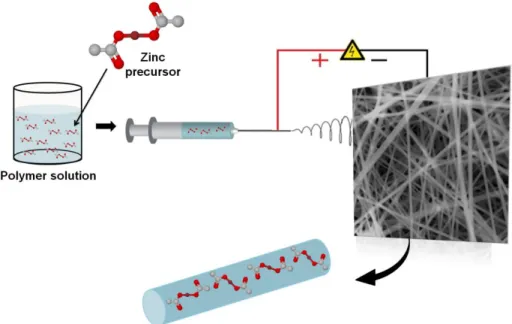NANOFIBROUS NANOCOMPOSITES VIA
ELECTROSPINNING
A THESIS
SUBMITTED TO THE MATERIALS SCIENCE AND NANOTECHNOLOGY
PROGRAM OF GRADUATE SCHOOL OF ENGINEERING AND SCIENCE
OF BILKENT UNIVERSITY
IN PARTIAL FULFILLMENT OF THE REQUIREMENTS
FOR THE DEGREE OF
MASTER OF SCIENCE
By
Ali Ekrem Deniz
ii
I certify that I have read this thesis and that in my opinion it is fully adequate, in scope and in quality, as a thesis of the degree of Master of Science.
……… Prof. Dr. Salim Çıracı (Advisor)
I certify that I have read this thesis and that in my opinion it is fully adequate, in scope and in quality, as a thesis of the degree of Master of Science.
………. Assist. Prof. Dr. Tamer Uyar (Co-Advisor)
I certify that I have read this thesis and that in my opinion it is fully adequate, in scope and in quality, as a thesis of the degree of Master of Science.
………. Assoc. Prof. Dr. Dönüş Tuncel
I certify that I have read this thesis and that in my opinion it is fully adequate, in scope and in quality, as a thesis of the degree of Master of Science.
………. Assist. Prof. Dr. Ali Çırpan
Approved for the graduate school of engineering and science: ……….
Prof. Dr. Levent Onural Director of the graduate school of engineering and science
iii
ABSTRACT
NANOFIBROUS NANOCOMPOSITES VIA
ELECTROSPINNING
Ali Ekrem Deniz
M.S. in Materials Science and Nanotechnology
Supervisor: Asst. Prof. Dr. Tamer Uyar
August, 2011
In recent years, numerous studies have been reported for fabrication of composite nanofibers from polymeric and inorganic materials by using electrospinning method. In the first part of this study, TiO2 and ZnO inorganic
nanofibers were produced by electrospinning from their precursors by using polymeric carrier matrix and their photocatalytic activity of these metal oxide nanofibers were studied. Moreover, electrospun TiO2 nanofibers were crushed
into short nanofibers (TiO2-SNF) and embedded in electrospun polymeric
nanofiber matrixes such as poly(methyl methacrylate) (PMMA), polyacrylonitrile (PAN), polyethylene terephthalate (PET), polycarbonate (PC) and polyvinylidene fluoride (PVDF). Different weight loading of TiO2-SNF
ranging from 2% to 8% (w/w, respect to polymer) incorporated into PVDF nanofibrous matrix was applied and the structural and morphological changes along with their photocatalytic activities were also examined.
iv
In the second part, metallic nanoparticles produced by laser ablation method were incorporated into nanofibrous polymeric matrix by using electrospinning technique. For example, gold (Au) and silver (Ag) nanoparticles (NPs) were produced from their metallic sources by laser ablation method directly in the polymer solutions. The NPs/polymer mixtures were electrospun and surface plasmon resonance effect of Au-NPs and Ag-NPs on optical properties of the nanofibers was studied. In addition, germanium nanocrystals produced by means of laser ablation were mixed with PVDF polymer solution and consequently electrospun into composite polymeric nanofiber matrix.
Keywords: Electrospinning, nanofibers, TiO2, ZnO, photocatalytic activity, laser
ablation, germanium nanocrystals, gold nanoparticles, silver nanoparticles, nanocomposites.
v
ÖZET
ELEKTROEĞĠRME ĠLE NANOFĠBRĠL YAPILI
NANOKOMPOZĠTLER
Ali Ekrem Deniz
Malzeme Bilimi ve Nanoteknoloji Programı, Yüksek Lisans Tez Yöneticisi: Yard. Doç. Dr. Tamer Uyar
Ağustos, 2011
Son yıllarda yapılan birçok çalışmada elektroeğirme tekniği kullanılarak polimerik ve anorganik malzemelerden kompozit nanofiberler üretildiği bildirilmektedir. Bu çalışmada, titanyum dioksit (TiO2) ve çinko oksit (ZnO)
anorganik nanofiberler, kimyasal başlangıç maddelerinden polimerik taşıyıcı matriks kullanılarak üretilmiş ve fotokatalitik aktiviteleri çalışılmıştır. Bundan başka, TiO2 nanolifleri TiO2 kısa nanoliflerine (TiO2-SNF) parçalanarak
poli(metil metakrilat) (PMMA), poliakrilonitril (PAN), poli(etilen teraftalat) (PET), polikaprolakton (PC) ve poli(viniliden florür) (PVDF) gibi elektroeğrilmiş polimerik nanolif matrikslerine yerleştirilmiştir. %2 den %8’e (ağırlıkça polimere oranla) değişen TiO2-SNF farklı ağırlıklarda PVDF nanolif
matriksine eklenmiştir ve fotokatalitik aktivitelerinin yanında yapısal ve morfolojik değişiklikler de gözlemlenmiştir.
vi
Ġkinci kısımda ise lazer ablasyon metoduyla üretilen metal nano parçacıklar polimerik nanolif matrikslerine elektroeğirme tekniği ile yerleştirilmiştir. Buna örnek olarak, altın (Au) ve gümüş (Ag) nano parçacıklar (NPs) metal kaynaklarından direk polimer solüsyonlarında lazer ablasyon sayesinde üretilmiştir. Bu NPs/polimer karışımları elektroeğrilmiş, Au-NPs ve Ag-NPs’nin yüzey plazmon rezonanslarının, polimerlerin optik özelliklerine etkisi çalışılmıştır. Buna ek olarak, germanyum nano kristalleri lazer ablasyon sayesinde üretilmiş, PVDF polimer solüsyonuyla karıştırılmış ve sonuç olarak kompozit polimer nanolif matriksi elektroeğirme ile elde edilmiştir.
Anahtar Kelimeler: Elektroeğirme, nanolif, TiO2, ZnO, fotokatalitik aktivite,
lazer ablasyon, germanyum nano kristalleri, altın nano parçacık, gümüş nano parçacık, nanokompozit.
vii
ACKNOWLEDGEMENT
I would like to express my sincere gratitudes to my supervisor Asst. Prof. Dr. Tamer Uyar for his guidance, support, and patience during the course of this research. One of the most right decisions in my life is joining the nanotextile research laboratory and being a member of such a beautiful group. I will never forget experience that I have benefited from greatly throughout my life.
We had a great atmosphere in the laboratory so I owe a special thank to Aslı Çelebioğlu, Fatma Kayacı and Zeynep Aytaç for their support, help, and friendship. It was wonderful to work with them.
I would like to thank Asst. Prof. Dr. Bülend Ortaç and his student Hüseyin Avni Vural for their collaboration with laser ablation experiments.
Also, I would like to acknowledge State Planning Organization (DPT) of Turkey for its support to UNAM Institute of Materials Science and Nanotechnology. Finally, I want to express my gratitude to my family for their endless support, and understanding.
viii
TABLE OF CONTENTS
ABSTRACT ... iii
ÖZET ... v
ACKNOWLEDGEMENT ... vii
TABLE OF CONTENTS ... viii
LIST OF FIGURES ... x
LIST OF TABLES ... xiv
PART 1 ... 1
INTRODUCTION ... 1
1.1. Electrospinning ... 1
1.2. Parameters of electrospinning ... 3
1.3. Electrospun nanofibers and their applications ... 5
PART 2 ... 10
CHAPTER I. INORGANIC NANOFIBERS ... 10
2.1. Inorganic nanofibers ... 10
2.2. Photocatalytic activity ... 11
2.3. Materials ... 13
2.4. Electrospinning unit at UNAM ... 13
2.5. Fabrication of titanium dioxide (TiO2) nanofibers via electrospinning .. 14
2.6. Characterization techniques... 16
2.7. Characterization of TiO2 nanofibers ... 16
2.8. Photocatalytic activity of TiO2 nanofibers ... 19
2.9. Fabrication of zinc oxide (ZnO) nanofibers via electrospinning ... 21
2.10. Characterization of ZnO nanofibers ... 22
ix
CHAPTER II. NANOCOMPOSITE NANOFIBERS ... 26
3.1. Nanocomposite nanofibers ... 26
3.2. Materials ... 28
3.3. Electrospun polymeric nanofibrous composites containing TiO2 short nanofibers (TiO2-SNF) ... 29
3.4. Photocatalytic activity of polyethylene terephthalate (PET) nanofibers containing TiO2-SNF ... 33
3.5. Polyvinylidene fluoride (PVDF) nanofibers with varying TiO2-SNF concentrations ... 34
3.6. Photocatalytic activity of PVDF nanofibers containing TiO2-SNF ... 43
CHAPTER III. FUNCTIONAL NANOFIBERS CONTAINING NANOPARTICLES ... 46
4.1. Functional nanofibers ... 46
4.2. Materials ... 48
4.3. Fabrication of PVP nanofibers containing Au and Ag nanoparticles by laser ablation method ... 48
4.4. Characterization of PVP nanofibers containing Au and Ag nanoparticles by laser ablation method ... 50
4.5. Fabrication of PVDF nanofibers contains Ge nanocrystals (Ge-NCs) by laser ablation method ... 55
4.6. Characterization of PVDF nanofibrous composites containing Ge-NCs by laser ablation method ... 57
CHAPTER 4 ... 60
CONCLUSION ... 60
FUTURE PROSPECTS ... 62
REFERENCES ... 63
x
LIST OF FIGURES
Figure 1 Schematic view of electrospinning ... 1 Figure 2 (a) Schematic representation of an electrospinning apparatus (r, radius of the capillary; R, curvature radius of the electrode used) and Taylor cones. (i) Formation of Taylor cone in an applied electric field. (ii) Taylor cone ejects fluid jet. (iii) Surface tension causes cone shape to relax [4]. (b) Photograph of a jet of PEO solution during electrospinning, (c) High-speed photograph of jet instabilities [5]. These figures were adapted from [4,5] with permission. ... 2 Figure 3 Representative SEM images of PAN nanofibers obtained from a) 15%, and b) 20% polymer concentrations. With increasing concentration, the bead structures are eliminated and bead-free, uniform PAN nanofibers are obtained. 4 Figure 4 General application areas of electrospun nanofibers ... 6 Figure 5 Mechanism of metaloxide photocatalysis. Picture is adapted with permission from [13]. The oxidizing species, OH• radicals are produced by the reaction between electron-hole pairs and H2O or surface-bound hydroxyl ion. 12
Figure 6 Electrospinning unit at UNAM consists of a) syringe pump, b) high voltage supply, and c) collector. ... 14 Figure 7 Schematic view of electrospun PVP nanofibers containing TiO2 sol
precursor from sol-gel polymer solution by applied voltage = 15 kV, feed rate = 0.5 ml/h, tip-to-collector distance = 10 cm. ... 15 Figure 8 SEM images of the electrospun nanofibers of (a) PVP/precursor and (c) TiO2 nanofibers and diameter ranges of (b) PVP/precursor and (d) TiO2
nanofibers. ... 17 Figure 9 (a) SEM image, (b)-(c) elemental maps and (d) EDX spectrum of TiO2
nanofibers showing that titanium and oxygen are the main elements of the nanofibers. ... 18 Figure 10 XRD pattern of TiO2 nanofibers having pure anatase structure ... 19
Figure 11 (a) UV-Vis spectrum of Rhodamine 6G solution containing TiO2
nanofibers, (b) the rate (C/C0) of Rhodamine 6G degradation by TiO2 nanofibers
by exposing UV light with 254 nm wavelength for 14 hours. ... 20 Figure 12 Schematic view of electrospun PVP nanofibers containing zinc acetate by applied voltage = 15 kV, feed rate = 0.5 ml/h, tip-to-collector distance = 13 cm. ... 22
xi
Figure 13 The SEM images of a) PVP nanofibers containing zinc acetate, ZnO nanofibers after calcination at 450 °C for 4 h. Magnification: b) 15000x, c) 100000x ... 23 Figure 14 (a) SEM image, (b)-(c) elemental maps and (d) EDX spectrum of ZnO nanofibers showing that zinc and oxygen are the main elements. ... 24 Figure 15 (a) UV-Vis spectrum of methylene blue solution containing ZnO nanofibers, (b) the rate (C/C0) of methylene blue degradation by ZnO nanofibers
by using UV treatment with 254 nm wavelength for 4 hours ... 25 Figure 16 Schematic illustration for a mesoporous TiO2 nanofiber and its
photocatalytic reaction mechanisms. Picture is adapted with permission from [19]. ... 27 Figure 17 SEM images (a) low-magnification and (b) high magnification of TiO2 nanofibers ranging 1 micron to several microns in length were obtained by
crushing in an agar mortar ... 29 Figure 18 Schematic view of electrospun polymeric nanofibers containing TiO2-SNF by applied voltage = 15 kV, tip-to-collector distance = 10 cm and
feed rate = 1 ml/h. ... 30 Figure 19 SEM images of nanofibrous composites with (1) low magnification and (2) high magnification: (a1)-(a2) PMMA/TiO2-SNF, (b1)-(b2) PAN/TiO2
-SNF, (c1)-(c2) PET/TiO2-SNF and (d1)-(d2) PC/TiO2-SNF. ... 31
Figure 20 TEM images of the PMMA/TiO2-SNF composite nanofibers showing
that some of the TiO2-SNF were fully covered by the polymeric matrix whereas
some TiO2-SNF were present on the surface of the polymeric matrix... 32
Figure 21 (a) The UV-Vis absorption spectrum of the Rh-6G solution containing PET/TiO2-SNF nanofibers as a function of the UV irradiation time,
and (b) the rate (C/C0) of Rh-6G degradation under UV irradiation at 254 nm
wavelength for 24 hours. ... 34 Figure 22 TEM images of the (a), (b) 2% (w/w) and SEM images of (c) 2% (d) 4% and (e) 8% (w/w) PVDF/TiO2-SNF nanofibers ... 35
Figure 23 (a) SEM image, (b)-(c)-(d)-(e) elemental maps and (f) EDX spectra of PVDF/TiO2-SNF nanofibers showing that carbon, oxygen, fluorine, and
titanium are the main elements of the nanofibers. ... 36 Figure 24 Raman spectrum of (a) neat PVDF nanofibers, (b) 2%, (c) 4%, and (d) 8% (w/w) PVDF/TiO2-SNF, and (e) crushed TiO2 nanofibers. ... 37
xii
Figure 25 XRD patterns of (a) neat PVDF nanofibers, (b) 2%, (c) 4%, and (d) 8% (w/w) PVDF/TiO2-SNF, and (e) crushed TiO2 nanofibers show characteristic
peak at 25.3o, 38.6o, 48.1o and 55.0o corrresponds to anatase type of TiO2 and its
intensity increase distinctly as its amount is increased at the sample. ... 39 Figure 26 Thermal gravimetric analysis of (a) neat PVDF, (b) 2%, (c) 4%, and (d) 8% (w/w) PVDF/TiO2-SNF nanofibers decompose at around 350 °C that is
lower than pure PVDF because of the catalytic property of the TiO2 nanofibers.
... 40 Figure 27 DSC thermograms of (a) 2%, (b) 4%, and (c) 8% (w/w) PVDF/TiO2
-SNF and (d) neat PVDF nanofibers showing that PVDF nanofibers and composites have a melting peak around 166 °C ... 41 Figure 28 The UV-Vis absorption spectrum of the Rh-6G solution containing PVDF/TiO2-SNF composite nanofibers including TiO2-SNF a) 2%, (b) 4%, and
(c) 8% (w/w) as a function of the UV irradiation time, and (d) the rate (C/C0) of
Rh-6G degradation by PVDF/TiO2-SNF composite nanofibers including TiO2
-SNF i) 2%, (ii) 4%, and (iii) 8% (w/w) ... 44 Figure 29 SEM images of the (a) 2%, (b) 4%, and (c) 8% (w/w) PVDF/TiO2
-SNF composite nanofibers after UV-Treatment in fiber morphology. ... 45 Figure 30 Schematic view of (a) formation nanoparticles in polymer solutions by laser ablation method by Bülend Ortaç research group, and (b) electrospinning process of them. ... 49 Figure 31 The representative (a), (b) SEM images of PVP/Au-NPs; (c), (d) Sem images of PVP/Ag-NPs nanofibers. Magnification: 5000x, 30000x ... 51 Figure 32 TEM images of (a) PVP/Au-Nps, and (b) PVP/Ag-Nps nanofibers . 52 Figure 33 EDX spectrums of (a) PVP/Au-Nps, and (b) PVP/Ag-Nps nanofibers ... 53 Figure 34 The FTIR spectrums of (i) pure PVP, (ii) PVP/Au-NPs, and (iii) PVP/Ag-NPs nanofibers. ... 54 Figure 35 The solid-state UV-Vis absorption spectrums of the (a) PVP/Au-NPs, and (b) PVP/Ag-NPs nanofibers. ... 54 Figure 36 Schematic view of electrospun PVDF nanofibers containing Ge-NCs ... 56 Figure 37 (a) SEM image, (b) The fiber diameter distribution histogram, (c) EDX spectrum, and (d) TEM image of PVDF/Ge-NCs composite nanofibers. 57
xiii
Figure 38 (a) UV-Vis absorption spectrums of Ge-NCs in acetone (black solid line) and NCs/PVDF nanofibers (red dashed line) and (b) PL spectra of Ge-NCs in acetone (black solid line) and Ge-Ge-NCs/PVDF nanofibers (red dashed line) ... 58
xiv
LIST OF TABLES
Table 1 Thermal properties and crystallinity of PVDF/TiO2-SNF composite
1
PART 1
INTRODUCTION
1.1.
Electrospinning
Electrospinning is a versatile and cost-effective technique for the production of multi-functional nanofibers from various polymers, polymer blends, composites, sol-gels, ceramics, etc. [1]. The basic principle of this technique is based on generating the direct movement of charged molecules by applying high voltage to supply the ejection of a liquid jet through spinneret from polymer solution droplet [2].
2
Electrospinning setup consists of three main components; high voltage power supplier, syringe pump and collector. Figure 1 shows the schematic view of electrospinning for polyacrylonitrile (PAN) nanofibers. When the electric field is created between the droplet of solution and the grounded collector, it overcomes the surface tension of solution and the polymer jet is formed for the fiber formation. The Taylor cone shape starts to be observed at the tip of the needle during the injection of this jet (Figure 2) [3]. The route of this charged jet is controlled by the electric field and bending instabilities which occur because of the repulsive forces existing in the jet. The bended jet extends through the collector hence it gets longer and thinner along with the evaporation of solvent by the collection of nanofiber structure [4].
Figure 2 (a) Schematic representation of an electrospinning apparatus (r, radius of the capillary; R, curvature radius of the electrode used) and Taylor cones. (i) Formation of Taylor cone in an applied electric field. (ii) Taylor cone ejects fluid jet. (iii) Surface tension causes cone shape to relax [4]. (b) Photograph of a jet of PEO solution during electrospinning, (c) High-speed
3
photograph of jet instabilities [5]. These figures were adapted from [4,5] with permission.
1.2.
Parameters of electrospinning
In electrospinning process, the morphology and uniformity of nanofibers are determined by considering a number of parameters which are investigated under two main parts: a) polymer/solution properties such as molecular weight, molecular weight distribution, viscosity, conductivity, dielectric constant, surface tension; and b) set-up parameters such as the electric field, the flow rate of solution, tip-to-collector distance. Moreover, the ambient parameters (temperature, humidity and air velocity in the chamber) may affect the formation of nanofibers.
The polymer/solution properties have the most important influence on the electrospinning process. For instance, the molecular weight of polymer type and the concentration of polymer solution should be high enough to provide the viscosity that is required for the curicial point of electrospinning; chain entanglement. It supplies the resistance also continuity of jet not to break into droplets and so prevents the bead formation during the process.
4
Figure 3 Representative SEM images of PAN nanofibers obtained from a) 15%, and b) 20% polymer concentrations. With increasing concentration, the bead structures are eliminated and bead-free, uniform PAN nanofibers are obtained.
Figure 3 shows the morphology tendency of electrospun PAN nanofibers in the increasing regime of concentrations. The beads structures are eliminated at higher concentration due to the adequate viscosity finally chain entanglement in the solution. Surface tension of polymer solution is another significiant parameter that is taken into account. To obtain continuous fiber structures, the surface tension should be overcome by electrical charge of solution. The higher viscosity yields into more interaction between solvent molecules and polymer chains hence it restricts the gathering of solvent molecules to form the surface tension in the spherical shape on the polmer jet.
The set-up parameters are the second important issue that has certain effect on the fiber morphology. One of them is the tip-to-collector distance. As the distance gets further, the thinner fibers can be obtained owing to more
5
stretching time during the collecting of nanofibers. Otherwise, the closer distance between needle and collector causes coarse fiber formation or collapsing problem with the insufficient solvent evaporation. The other most decisive parameter of electrospinning process is applied voltage. The increasing voltage leads to decreasing at fiber diameter because fibers are exposed to more stretching under high electrical field. However, in the case of higher voltage, the fiber diameter indicates increasing because of the higher amount of pumped polymer solution [1, 2, 6].
1.3.
Electrospun nanofibers and their applications
The electrospinning process can be carried with any soluble synthetic or natural polymer type having enough molecular weight. Electrospun nanofibers are easily obtained from synthetic polymer types like; nylon, polyesters, polyurethane etc. and also from natural polymers such as; collagen, silk, chitosan, alginate, cellulose etc. [3]. Moreover, metal oxide nanofibers are acquired by using suitable precursors in the polymer matrix. Nanofibers are not only produced from unique structures. To attain from the multifunctional properties of composite materials, they can also be performed so as to be in blend form or can be combined with additives such as; nanoparticles, drugs and different kinds of chemical components [1].
Nowadays, nanofibers have received considerable attention of materials science due to their exclusive properties that can be implemented in specific areas such as catalysis, filtration, nanocomposites, nanofibrous structures,
6
protective textiles, tissue scaffolds, drug delivery systems, etc. (Figure 4) [7].
Figure 4 General application areas of electrospun nanofibers
Nanomaterials are of great interest as catalyst substrates owing to their large surface area and high catalyst loading capacity [7]. Nanofibrous catalysts could replace catalytic nanoparticles in order to transcend the issue of catalyst recovery. They have several advantages, such as flexibility in shape and low resistance to the flow of gases and liquids [8]. The activity of the catalyst supported on a substrate mainly depends on its large active surface area. Nonporous substrates can be coated with a high surface area material like nanofibers in order to increase the surface area, thus improving reactivity [8]. For instance, carbon nanofiber supports loaded with iron particles have demonstrated high conversion of hydrocarbons in comparison with active carbon and γ-alumina. It has been observed that the intrinsic
7
catalyst effect is more evident when loaded in smaller diameter fibers such as nanofibers [7].
Filtration is another area where nanofibers have been implemented. Polymeric nanofibers have been utilized in air filtration applications for more than a decade [8]. The small fiber diameters cause slip flows at fiber surfaces, causing an increase in the interception and inertial impaction efficiencies of these composite filter media. The enhanced filtration efficiency at the same pressure drop becomes feasible with fibers having diameters less than 0.5 micron. The implementation of nanofiber networks as a filtering medium holds promising potential. Keeping in mind that the essential features of protective clothing are high atmospheric moisture transport, increased fabric breathability, and enhanced toxic chemical resistance, electrospun nanofiber membranes stand as good candidates for these applications. The highly porous electrospun membrane surfaces aid in moisture vapor transport [7].
Moreover, tissue scaffolds and drug delivery are other well-known application areas of nanofibers. Nanofibers with high surface area and porosity have enormous potential for applications in engineering mechanically stable and biologically functional tissue scaffolds. The tissue scaffolding material must be selected carefully to ascertain its biocompatibility with the body cells. The biocompatibility depends on the surface chemistry of the scaffolds, which is dictated by the material properties [9]. The high surface to volume ratio of the nanofiber provides
8
more space for the cell attachment than the regular fibers. The dimensions of these engineered scaffolds were in the comparable scale with those of the natural extra cellular matrix. Electrospun biodegradable polymers are considered as suitable scaffolds for tissue engineering, with their big pore diameter and volume. The high porosity of the electrospun nanofiber scaffolds provides enough space for the cell accommodation and an easy passage for the nutrients and metabolic waste excretion. Mechanical properties like elasticity modulus and strain at failure are important for the application of electrospun nanofibers as tissue scaffolds [7, 9]. Moreover, nanofiber mats with their unique functional characteristics find application as drug carriers for the drug delivery system. Controlled delivery of drugs at a defined rate over a span of treatment is possible with biocompatible delivery matrices of either biodegradable or nonbiodegradable polymers [10].
In addition, electrospun nanofiber membranes also stand as potential candidates for protective clothing applications, because of their light weight, large surface area, high porosity, great filtration efficiency, effective resistance to penetration of harmful chemical agents in aerosol form and their ability to neutralize the chemical agents without impedance of the air and humidity permeability. Many methods for modification of nanofiber surfaces have been tried in order to achieve improvement in protection against toxins and one of the protection methods that has been used includes chemical surface modification and attachment of reactive moieties such as oximes, cyclodextrins, and chloramines [3].
9
Polymeric conductive membranes have enormous potential for applications such as, photovoltaic devices, electrostatic dissipation, corrosion protection, electromagnetic interference shielding, fabrication of electronic devices and sensors. Conductive membranes comprised of nanofibers can also be implemented for use as porous electrodes in developing high performance batteries and polymer electrolyte membrane fuel cells, due to their high porosity and inherent large surface area. Conductive nanofibers offer valuable properties of polymer batteries, for instance, reduced electrolyte leakage, high dimension flexibility, and high energy density per unit mass [3].
As is evident from the aforementioned brief discussion on the applications of nanofibers, the potential of nanostructured materials in advanced applications is highly promising (Figure 4). Researchers are constantly making efforts to exploit the high surface area and porosity properties to develop sophisticated state of art materials.
10
PART 2
CHAPTER I. INORGANIC NANOFIBERS
2.1.
Inorganic nanofibers
Inorganic nanomaterials exhibit extraordinary chemical and physical features such as magnetic, electrical, optical and catalytic properties. There are numerous methods including; deposition, ball milling technique, synthesis in reversed micelles, Langmuir–Blodgett film, and self-assembled monolayers. In additon to these methods, combining the sol-gel processing and electrospinning technique enables us to produce inorganic nanofibers in a very practical manner. That method can be summarized with three steps; Firstly, a sol with suitable inorganic precursor and polymer system were prepared. Secondly, electrospinning procedure was applied with suitable parameters. Finally, inorganic nanofibers were obtained by calcinating the polymeric carrier matrix. For instance, titanium dioxide (TiO2), silicon
dioxide (SiO2), zinc oxide (ZnO), aluminum oxide (Al2O3) and zirconium
dioxide (ZrO2) are the most commonly known metal oxide nanofiber types
obtained by this method. Due to their high specific surface area, more active sites, abundant inner spaces and heterogenous interfaces, inorganic nanofibers show superiority according to their bulk form in terms of electrical, optical and catalytic properties. Especially TiO2 nanofibers can be
11
anode material for lithium-ion batteries and photocatalysts for filtration membranes [11, 12, 43].
2.2.
Photocatalytic activity
The acceleration of photoreaction with the help of catalyst is called as photocatalysis. During the reaction, a substrate absorbs light and creates electron hole pairs that have ability to generate free radicals. The materials having photocatalytic property can be used for the destruction of organic pollutants in the water. Over the years, a large number of metal oxides have been utilized as photocatalysts for this purpose. The most commonly studied ones are TiO2 and ZnO because of their high photosensitivity, nontoxic
nature and large band gap. Due to their properties, both of them have the availability to be used for the detoxification of water from organic pollutants. When aqueous solution of TiO2 is irradiated with photons whose
energy is equal to or greater than its band gap energy (Eg = 3.2 eV) i.e., with λ < 380 nm,electron-hole pairs are developed (Figure 5).
TiO2 + hv TiO2 (e- + h+)
Then, the hole produced by UV-light reacts with H2O or surface-bound
hydroxyl ion to produce OH• radicals which is the most oxidizing species in this process.
TiO2 (h+)+ H2O HO• + H+
12
On the other hand, electrons released by irridation of photocatalyst combines with dissolved molecular oxygen to form superoxide anion radical O2•
−
. Then, these superoxide radicals generate peroxides which are able to combine with electron and form OH• radicals in the medium.
O2•- + e- + H+ H2O2
H2O2 + e- HO• + OH-
Finally, hydroxyl radicals decompose by oxidizing the organic pollutants (OP) into non-toxic materials such as CO2 and water.
HO•+ OP CO2 + H2O
Figure 5 Mechanism of metaloxide photocatalysis. Picture is adapted with permission from [13]. The oxidizing species, OH• radicals are produced by the reaction between electron-hole pairs and H2O or surface-bound hydroxyl
13
ZnO is also considered as a suitable photocatalytic agent due to its similar mechanism and bandgap energy with TiO2. Moreover, it is one-up
owing to its low cost, absorption ability of larger fraction at UV spectrum and avaibility to be used in commercial range in higher efficiency especially for herbicides and pesticides [10-12].
2.3.
Materials
Titanium (IV)-isopropoxide (97%, Aldrich), zinc acetate dihydrate (reagent grade, Aldrich), glacial acetic acid (% 100, Merck), ethanol (≥ 99.8%, Sigma-Aldrich), dimethylformamide (DMF) (Riedel, Pestenal), polyvinylpyrrolidone (PVP, Mw~1300000, Aldrich) were used as-received without any further purification.
2.4.
Electrospinning unit at UNAM
Electrospinning unit at UNAM consists of syringe pump, high voltage supply, and a collector (Figure 6). Syringe pump (Model: SP 101IZ, WPI) is situated horizontally, and electric field was comprised by the high voltage power supply (Matsusada Precision, AU Series, Japan). Mostly, electrospun nanofibers were deposited on a grounded stationary cylindrical metal collector covered by a piece of aluminum foil. The electrospinning was carried out in enclosed Plexiglas box. That box is suctioned by portative hood for protection from hazardous solvents. Inside temperature and relative humidity are monitored by scientific wireless thermo-hygrometer (Honeywell, TM0005-X).
14
Figure 6 Electrospinning unit at UNAM consists of a) syringe pump, b) high voltage supply, and c) collector.
2.5.
Fabrication of titanium dioxide (TiO
2) nanofibers
via electrospinning
Firstly, solvent system was prepared by mixed with glacial acetic acid (2 ml) and ethanol (2 ml). Then, titanium (IV)-isopropoxide (2.88 ml) as a precursor was added into this solvent system. After stirring for 10 min, carrier polymer in electrospinning process which is PVP (0.6 g) dissolved in ethanol (3 ml) was added to this solution. Finally, the mixture was constantly stirred for 12 hours until the yellowish sol-gel was obtained.
For electrospinning process, the PVP solution which contains TiO2 sol
precursor was placed into a 1 ml syringe having metallic needle tip (inner diameter=0.4 mm). The syringe pump was used horizontally to feed the polymeric solution. The electrical field was generated by using high voltage
15
power supply. The electrospinning parameters were adjusted by applied voltage = 15 kV, feed rate = 0.5 ml/h, tip-to-collector distance = 10 cm. Finally, electrospun nanofibers were deposited on a grounded stationary cylindrical metal collector covered by a piece of aluminum foil (Figure 7).
Figure 7 Schematic view of electrospun PVP nanofibers containing TiO2 sol
precursor from sol-gel polymer solution by applied voltage = 15 kV, feed rate = 0.5 ml/h, tip-to-collector distance = 10 cm.
The experiments were carried out in the closed Plexiglass box in order to provide protection from hazardous volatile solvents of process. Temperature and relative humidity were recorded as 23 oC and 26 %. After the electrospinning process, nanofibers were dried overnight under the hood and then calcinated at 500 oC for 3 hours in an industrial oven in order to obtain pure TiO2 nanofibers.
16
2.6.
Characterization techniques
Scanning electron microscope (SEM) (FEI - Quanta 200 FEG) and transmission electron microscope (TEM) (FEI - Tecnai G2F30) were used for the morphological investigation of the nanofibers. The fiber diameter range and the average fiber diameter were determined from the SEM images and around 100 fibers were analyzed. Energy dispersive X-ray (EDX) was performed for the elemental analysis of the TiO2 and ZnO nanofibers. The
X-ray diffraction (XRD) patterns for these metal oxide nanofibers were obtained by using PAN analytical X’Pert Powder diffractometer with Cu Kα radiation in a range 2θ=10o-70o. UV-Vis-NIR spectrophotometer (Varian Cary 5000) was used to analyze photocatalytic degradation of Rhodamine-6G and methylene blue dye solutions including TiO2 and ZnO nanofibers,
respectively.
2.7.
Characterization of TiO
2nanofibers
The representative SEM images and fiber diameter distributions of the electrospun nanofibers of PVP/precursor and TiO2 are shown in Figure 8.
Bead-free nanofibers of PVP/precursor (Figure 8-a) and TiO2 (Figure 8-c)
were obtained with diameters in the range of 60-850 nm (Figure 8-b) and 40-500 nm (Figure 8-d) having average fiber diameter of 300±130 nm and 200±120 nm, respectively.
17
Figure 8 SEM images of the electrospun nanofibers of (a) PVP/precursor and (c) TiO2 nanofibers and diameter ranges of (b) PVP/precursor and (d)
TiO2 nanofibers.
SEM findings suggest that diameter of composite materials decreases by removal of organic component (PVP) by calcination at 500 oC for 3 hours. During the calcination process of PVP/titanium precursor, the material maintained its fibrous structures and brittle TiO2 nanofibers were obtained
and the energy dispersive X-ray spectroscopy (EDX) analyses of TiO2
nanofibers were performed (Figure 9). The elemental mapping of TiO2
nanofibers by EDX showed that titanium and oxygen are the main elements of the nanofibers.
18
Figure 9 (a) SEM image, (b)-(c) elemental maps and (d) EDX spectrum of TiO2 nanofibers showing that titanium and oxygen are the main elements of
the nanofibers.
The crystalline structure of TiO2 nanofibers was identified by X-ray
diffraction (XRD). Figure 10 has shown the XRD of TiO2 nanofibers with
series of diffraction peaks corresponding to anatase phase which is known for its photocatalytic activity. The salient peak at 2θ=25.4o corresponds to the (101) plane of the anatase TiO2 structure and the other peaks at 2θ=38.1o,
48.4o, 54.3o, 55.3o, 63.0o, 69.1o, correspond to the diffraction of (004), (200), (105), (211), (204), (116), and (220) planes, respectively [16]. XRD pattern of the TiO2 nanofibers has no diffraction peak at 2θ=27.5o which is
characteristic for the rutile phase signifying that calcination process yielded TiO2 nanofibers having pure anatase structure.
19
Figure 10 XRD pattern of TiO2 nanofibers having pure anatase structure
2.8.
Photocatalytic activity of TiO
2nanofibers
The photocatalytic degradation of rhodamine-6G dye solution was used as a model photoreaction and its degradation was followed by the UV-Vis absorption measurement of the solution containing TiO2 nanofibers by using
UV treatment with 254 nm wavelength for 14 hours. They are placed into quartz cuvettes (10.00 mm, Hellma) with a distance of 5 cm from the UV source (8 W, UVLMS-38 EL). At known time intervals, the dye concentration was measured by using UV-Vis-NIR spectrophotometer.
When rhodamine 6G solution containing TiO2 nanofibers was exposed to
UV light, we observed that the solution turned colorless. The change in the absorbance on the UV-Vis spectrum of the Rh-6G solution containing TiO2
20
Rhodamine 6G with TiO2 nanofibers as a catalyst decomposed completely
after 14 hours under UV. Figure 11-b shows the rate (C/C0) of Rhodamine
6G degradation where C0 and C indicate the initial concentration of
rhodamine 6G before UV irradiation and after UV irradiation at time t, respectively.
Figure 11 (a) UV-Vis spectrum of Rhodamine 6G solution containing TiO2
nanofibers, (b) the rate (C/C0) of Rhodamine 6G degradation by TiO2
21
2.9.
Fabrication of zinc oxide (ZnO) nanofibers via
electrospinning
Firstly, PVP; carrier polymer (0.400 g) was dissolved in a solvent system consisting of ethanol (2 ml) and DMF (2 ml). Then, zinc acetate (1.400 g) was added into this polymeric solution. Finally, the mixture was constantly stirred for one hour until the transparent solution was obtained.
For electrospinning process, the PVP solution containing zinc acetate was placed into a 3 ml syringe having metallic needle tip (inner diameter=0.6 mm). The syringe pump and high voltage power supply are the same with previous experiments. The electrospinning parameters were adjusted as applied voltage = 15 kV, feed rate = 0.5 ml/h, tip-to-collector distance = 13 cm. Finally, electrospun nanofibers were deposited on a grounded stationary cylindrical metal collector covered by a piece of aluminum foil. The electrospinning was carried out in enclosed plexiglass box and at 20 oC at 33 % relative humidity (Figure 12). The electrospun nanofibers were dried overnight under the hood and then calcinated at 450 °C for 4 h in an oven in order to obtain pure ZnO nanofibers.
22
Figure 12 Schematic view of electrospun PVP nanofibers containing zinc acetate by applied voltage = 15 kV, feed rate = 0.5 ml/h, tip-to-collector distance = 13 cm.
2.10.
Characterization of ZnO nanofibers
ZnO nanofibers are analyzed by SEM and EDX to investigate the nanostructure and chemical composition. SEM images revealed that ZnO nanofibers are obtained in grains morphology after the calcination of PVP/zinc acetate composites web (Figure 13).
23
Figure 13 The SEM images of a) PVP nanofibers containing zinc acetate, ZnO nanofibers after calcination at 450 °C for 4 h. Magnification: b) 15000x, c) 100000x
Elemantal maps of ZnO nanofibers show that zinc and oxygen are the main elements of the nanofibers. ZnO nanofibers having diameters in the range of 20-1100 nm with average fiber diameter of 200 ±180 nm were obtained (Figure 14).
24
Figure 14 (a) SEM image, (b)-(c) elemental maps and (d) EDX spectrum of ZnO nanofibers showing that zinc and oxygen are the main elements.
2.11.
Photocatalytic activity of ZnO nanofibers
Photocatalytic activity of the ZnO nanofibers was evaluated by measuring the photocatalytic degradation of methylene blue solution by using UV treatment with 254 nm wavelength for 4 hours. They are placed into quartz cuvettes with a distance of 5 cm from the UV source. At known time intervals, the dye concentration was measured by using UV-Vis-NIR spectrophotometer. After the UV treatment, the methylene blue solution containing ZnO nanofibers become colorless (Figure 15-a). Changes in the concentration of methylene blue with respect to time were examined by
UV-25
Vis-NIR spectrophotometer at the wavelength of 665 nm which is the maximal absorption. Methylene blue solution containing ZnO nanofibers decomposed completely after 4 hours under UV. Figure 15-b shows the rate (C/C0) of methylene blue degradation where C0 and C indicate the initial
concentration of methylene blue before UV irradiation and after UV irradiation at time t, respectively.
Figure 15 (a) UV-Vis spectrum of methylene blue solution containing ZnO nanofibers, (b) the rate (C/C0) of methylene blue degradation by ZnO
26
CHAPTER II. NANOCOMPOSITE NANOFIBERS
3.1.
Nanocomposite nanofibers
Composites are prominent materials with their multifunctional properties originated from the combination of two or more constituent materials with their distinct physical and/or chemical features. These composite structures generally have advantages in terms of mechanical, thermal, electrical, optical, electrochemical and catalytic properties [45]. In the case of nanocomposite production, the mentioned properties are significantly improved due to the expectional high surface to volume ratio. Polymeric matrix supplies the enchancement at the performance of composite materials by capitalizing the properties of nanofillers so they are generally considered as an excellent carrier for nanocomposite materials. However, to attain the high performance composites, the good dispersion of nanofillers is required in the polymeric media [46]. From this point of view, electrospun nanofibers can be accepted as a great candidate to constitute carrier matrix that supplies the homogenous dispersion of nanofillers. For instance, TiO2 nanoparticles
were incorporated into PVP nanofiber matrices via coupling sol–gel method and electrospinning technique to achieve the production of photoluminescent (PL), electroluminescent (EL) and non-linear optical devices [47]. On the other hand, TiO2 can be produced in the form of both nanoparticles and
nanofiber but it was investigated that TiO2 nanofibers show higher
photocatalytic activity when it is compared to nanoparticle types so the adding type of TiO2 was determined as short nanofibers because of the
27
effects of mesoporosity and interparticle charge transfer (Figure 16) [19]. For this purpose, we obtained pure anatase TiO2 short nanofibers (TiO2–
SNF) by crushing the nanofiber structure and they were used to produce polymeric nanofibrous composite structures. We obtained electrospun nanofibers from different polymer types such as poly(methyl methacrylate) (PMMA), polyacrylonitrile (PAN), polyethylene terephthalate (PET), polycarbonate (PC) and polyvinylidene fluoride (PVDF) containing TiO2–
SNF.
Figure 16 Schematic illustration for a mesoporous TiO2 nanofiber and its
photocatalytic reaction mechanisms. Picture is adapted with permission from [19].
As a preliminary study, the photocatalytic activity of PET nanofibers containing TiO2–SNF was investigated for photocatalytic decomposition of
rhodamine-6G under UV irradiation. Additionally, the different loading effect of TiO2–SNF on photocatalytic activity was studied in PVDF
28
nanofiber matrix which has the unique properties of nanofiber/nanoweb systems. These examples are the very first reports showing that short metal oxide nanofibers can be incorporated into polymeric nanofibers via electrospinning. Such nanofibrous composite structures can be obtained from different polymer types and will be applicable in various areas depending on the polymer type and the function of metal oxides.
3.2.
Materials
Titanium (IV)-isopropoxide (97%, Aldrich), glacial acetic acid (% 100, Merck), ethanol (≥ 99.8%, Sigma-Aldrich), dimethylformamide (DMF) (Riedel, Pestenal), tetrahydrofuran (THF) (≥ % 99.5, Sigma), dichloromethane (DCM) (≥ %99, Sigma), trifluoroacetic acid (TFA) (% 99, Sigma-Aldrich), polyvinylpyrrolidone (PVP, Mw~1300000, Aldrich), poly(methyl methacrylate) (PMMA) (Mw~350000, Aldrich), polyacrylonitrile (PAN) (donated by AKSA Co., Turkey), polyethylene terephthalate (PET) (donated by Korteks Co., Turkey), polycarbonate (PC) (Mw~64000, Aldrich), polyvinylidene fluoride (PVDF) (Kynar 761, donated by Elf Atochem North America Inc.) were used as-received without any further purification. The water was used from Millipore Milli-Q Ultrapure Water System.
29
3.3.
Electrospun polymeric nanofibrous composites
containing TiO
2short nanofibers (TiO
2-SNF)
Firstly, TiO2 short nanofibers (TiO2–SNF) ranging 1 micron to several
microns in length were obtained by crushing the electrospun TiO2 nanofibers
in a mortar (Figure 17).Then, the concentration of the polymer solutions and the electrospinning parameters were optimized in order to get bead-free uniform fibers. The polymer solutions were prepared as follows: PMMA and PAN were dissolved in DMF using 12.5% (w/v) and 20% (w/v) polymer concentration, respectively. In addition, 20% (w/v) PET was dissolved in TFA:DCM (1:1, v/v), while 25% (w/v) PC was dissolved in THF:DMF (3:2, v/v) solvent system.
Figure 17 SEM images (a) low-magnification and (b) high magnification of TiO2 nanofibers ranging 1 micron to several microns in length were obtained
by crushing in an agar mortar
Afterwards, previously prepared TiO2–SNFs were blended with polymer
30
and 2% TiO2-SNF (w/w, with respect to polymer) in PAN, PET and PC
solutions were dispersed by stirring for 1 h. The percentage loading of TiO2
-SNF was affecting the electrospinning, therefore, TiO2-SNF loading was
chosen for each polymer solution that did not affect the electrospinning of bead-free nanofibers. Subsequently, PAN, PET and PC solutions were electrospun into nanofibers in order to produce nanofibrous composite structures with the following parameters: applied voltage = 15 kV, tip-to-collector distance = 10 cm and feed rate = 1 ml/h. For PMMA solution the parameters were as follows: applied voltage = 10 kV, tip-to-collector distance = 15 cm and feed rate = 1 ml/h. These electrospun nanofibrous composites were abbreviated as; PMMA/TiO2-SNF, PAN/TiO2-SNF,
PET/TiO2-SNF and PC/TiO2-SNF (Figure 18).
Figure 18 Schematic view of electrospun polymeric nanofibers containing TiO2-SNF by applied voltage = 15 kV, tip-to-collector distance = 10 cm and
31
Figure 19 SEM images of nanofibrous composites with (1) low magnification and (2) high magnification: (a1)-(a2) PMMA/TiO2-SNF,
32
The representative SEM images of these nanofibrous composites are depicted in Figure 19. We observed that the incorporation of TiO2-SNF did
not affect the electrospinning of these polymers and bead-free nanofibers were obtained in all cases.
Figure 20 TEM images of the PMMA/TiO2-SNF composite nanofibers
showing that some of the TiO2-SNF were fully covered by the polymeric
matrix whereas some TiO2-SNF were present on the surface of the polymeric
matrix.
We further analyzed these nanofibrous composites by TEM. The representative TEM images of the PMMA/TiO2-SNF composite nanofibers
are given in Figure 20. SEM and TEM analyses revealed that some of the TiO2-SNF were fully covered by the polymeric matrix whereas some TiO2
-SNF were present on the surface of the polymeric matrix and/or sticking out from the polymeric matrix.
33
3.4.
Photocatalytic activity of polyethylene terephthalate
(PET) nanofibers containing TiO
2-SNF
As mentioned above, TiO2-SNF have anatase structure which is known
for its photocatalytic activity. As a preliminary study, we also investigated the photocatalytic activity of PET/TiO2-SNF nanofibers. The photocatalytic
activity was analyzed by photodegradation of rhodamine-6G (2x10-5 M) in aqueous medium. PET nanofibers containing crushed TiO2 nanofibers (2 mg,
1.0 cm x 1.0 cm) were put into quartz cuvette filled with rhodamine-6G solution. The cuvette was placed with a distance of 5 cm from the UV source and kept under UV irradiation at 254 nm wavelength. At known time intervals, the dye concentration was measured by using UV-Vis-NIR spectrophotometer. The change in the absorbance on the UV-Vis absorption spectrum of the Rh-6G solution containing PET/TiO2-SNF nanofibers as a
function of the UV irradiation time is shown in Figure 21. This figure also shows the rate (C/C0) of Rh-6G degradation where C0 and C indicate the
initial concentration of Rh-6G before UV irradiation and after UV irradiation at time t, respectively.
34
Figure 21 (a) The UV-Vis absorption spectrum of the Rh-6G solution containing PET/TiO2-SNF nanofibers as a function of the UV irradiation
time, and (b) the rate (C/C0) of Rh-6G degradation under UV irradiation at
254 nm wavelength for 24 hours.
As the photodegradation of Rh-6G occurred with respect to UV irradiation time, the absorbance of the Rh-6G solution in the UV-Vis absorption spectrum decreased gradually, and the red color of the solution disappeared totally after 24 hours of UV irradiation indicating that almost 100% of the Rh-6G was decomposed. This result confirmed the photocatalytic degradation of Rh-6G by nanofibrous composites.
3.5.
Polyvinylidene fluoride (PVDF) nanofibers with
varying TiO
2-SNF concentrations
Firstly, polymer solution was prepared as follows: 20 % (w/v) PVDF dissolved in DMAc: Acetone (1:1, v/v). Then TiO2-SNF were added in
PVDF solution were dispersed by stirring for one hour with the ratios 2%, 4%, and 8% (w/w) (with respect to polymer). Finally, PVDF solution was
35
electrospun with following parameters: applied voltage = 20 kV, tip-to-collector distance =10 cm and feed rate = 1 ml/h.
Figure 22 TEM images of the (a), (b) 2% (w/w) and SEM images of (c) 2% (d) 4% and (e) 8% (w/w) PVDF/TiO2-SNF nanofibers.
TEM and SEM images showed that nanofibers were detected as black and white segments, respectively and and it was observed that they preserved their original structure (Figure 22). The elemental mapping of PVDF nanofibers containing TiO2–SNF by EDX showed that carbon,
oxygen, fluorine, and titanium are the main elements of the nanofibers (Figure 23).
36
Figure 23 (a) SEM image, (b)-(c)-(d)-(e) elemental maps and (f) EDX spectra of PVDF/TiO2-SNF nanofibers showing that carbon, oxygen,
fluorine, and titanium are the main elements of the nanofibers.
According to literature, three main crystalline forms of PVDF have distinct molecular conformations; which are all trans structure (β- phase), trans-gauche structure (α-phase), and an intermediate conformation, consisting in sequences of three trans bonds separated by a gauche bond, is found in the case of γ- phase [21].
37
Figure 24 Raman spectrum of (a) neat PVDF nanofibers, (b) 2%, (c) 4%, and (d) 8% (w/w) PVDF/TiO2-SNF, and (e) crushed TiO2 nanofibers.
Figure 24 shows the Raman spectra of pure PVDF, TiO2 nanofibers and
PVDF nanofibers including TiO2 – SNF in 2%, 4%, 8% (w/w)
concentrations. The PVDF nanofiber spectrum presents absorption peaks in 1426 (CH2 bending), 836 (CH2 rocking), 2969 and 2986 (CH2 symmetric
streching) wavenumber. Moreover, 795 cm-1 is the characteristic of the alpha-phase (CH2 rocking). These peaks are fitted with our data [22] which
are 1430, 839 and 795 cm-1 and two peaks around 3000 cm-1, respectively. 839 cm−1 is common to both forms I and III but is very strong only in the first case, while the 811 cm−1 band is only characteristic of form III, which shows that PVDF nanofibers have a crystalline form of β- phase inspite of γ- phase. Moreover, the band at 795 cm-1 characteristic of the alpha-phase
38
(form 2) and assigned to CH2 rocking [23]. Raman indicates the crystalline
forms of PVDF which is mixture of α-phase and β- phase.
On the other hand, The TiO2 nanofibers spectrum shows absorptions in
the 151, 401, 516 and 639 cm-1 wavenumbers. According to literature [24] anatase TiO2 has the Raman lines at 151, 409, 515 and 633 cm−1 can be
assigned as the Eg, B1g, A1g or B1g, showing excellent agreement with the literature. Moreover, it is clearly observed that while TiO2-SNF was added
occurred ascendings in the absorption spectrum in the 151, 409, 515 and 633 cm−1, however the band at 795 cm-1 characteristic of the alpha-phase (form 2) and assigned to CH2 rocking appears regardless the amount of TiO2-SNF.
[22] On the other hand, band at 840 cm− 1 that designates the polar β-phase of the polymer decreases. This conformational change of the polymer has also been observed for other PVDF/TiO2-SNF nanocomposite nanofibers
which obviously says that β → α transition in all membranes regardless the amount of TiO2-SNF.
Figure 25 indicates the X-ray patterns of pure PVDF, TiO2 nanofibers
and PVDF nanofibers including TiO2–SNF in 2%, 4%, 8% (w/w)
concentrations. Crystalline structure of PVDF polymers show α-, β-, γ- phase and each phase have specific diffraction peaks in 2θ Bragg angle during XRD measurement. The electrospun PVDF nanofibers can be determined as the combination of two crystalline type because while the 18.4o (020), 27.8o (111) correspond to the α-phase, 20.8o (110), 20.7o (200), and 36.6o (020) stand for β-phase cystalline structure. Also pure TiO2
39
nanofibers show characteristic peak at 25.3o, 38.6o, 48.1o and 55.0o corrresponds to anatase type of TiO2 and its intensity increase distinctly as its
amount is increased at the sample. To the contrary, the specific peak of PVDF show decline in intensity because of more dominant crystalline structure of TiO2-SNF additive.
Figure 25 XRD patterns of (a) neat PVDF nanofibers, (b) 2%, (c) 4%, and (d) 8% (w/w) PVDF/TiO2-SNF, and (e) crushed TiO2 nanofibers show
characteristic peak at 25.3o, 38.6o, 48.1o and 55.0o corrresponds to anatase type of TiO2 and its intensity increase distinctly as its amount is increased at
the sample.
Differential scanning calorimeter (DSC) and thermogravimetric (TGA) methods were carried out in increasing concentration of TiO2–SNF to
observe the TiO2–SNF effect on the thermal behavior of PVDF nanofibers.
40
content. For pure PVDF nanofibers, strong one-step degradation was observed above 450 °C. On the other hand, composite PVDF nanofibers indicate decomposition behavior at around 350 °C that is lower than pure PVDF. This can be originated from the catalytic property of the TiO2
causing oxidative and earlier decomposition of samples during the process [20].
Figure 26 Thermal gravimetric analysis of (a) neat PVDF, (b) 2%, (c) 4%, and (d) 8% (w/w) PVDF/TiO2-SNF nanofibers decompose at around 350 °C
that is lower than pure PVDF because of the catalytic property of the TiO2
41
Figure 27 DSC thermograms of (a) 2%, (b) 4%, and (c) 8% (w/w) PVDF/TiO2-SNF and (d) neat PVDF nanofibers showing that PVDF
nanofibers and composites have a melting peak around 166 °C
Figure 27 shows the graph of heat flow versus temperature for PVDF nanofibers and PVDF/ TiO2–SNF composites samples. It is observed that
PVDF nanofibers and composites show an endothermic melting peak around 166 °C, this behavior is characteristic of the PVDF alpha phase [20]. It slightly changes depending on the concentration of TiO2-SNF.
42 Sample Melting temperature (oC) Melting enthalpy (J/g) Crystallinity (%) XRD DSC Pure PVDF 166.3 78.8 74.1 75.2 PVDF + 2% TiO2 - SNF 166.7 86.9 81.5 82.9 PVDF + 4% TiO2 - SNF 166.2 79.7 74.3 76.1 PVDF + 8% TiO2 - SNF 165.4 75.2 70.2 71.8
Table 1 Thermal properties and crystallinity of PVDF/TiO2-SNF composite
nanofibers with different TiO2-SNF contents
Table 1 indicates the crystalline percentages that were calculated from the DSC data with the following formula.
Where ΔH*
m is the melting enthalpy for totally crystalline PVDF.
Assuming the same melting enthalpy for all crystalline forms of PVDF, the melting enthalpy of 100% crystalline was given as 104.7 J/g [41]. However it is not definite regime because, while the concentration of TiO2-SNF at 2%,
the crystallinity percentage increases to 82.9%. On the other hand, as the content percentage is increased to 4% and 8%, it is observed that the crystallinity decrease significantly to 76.1% and 71.8%, respectively. This case can be based on the fact that, TiO2-SNF enhance the crystalline
nucleation of PVDF at the 2% concentration but behaves as anti-nucleating agent at the 4% and 8% concentrations [20]. The crystallinity percentages were also calculated from XRD patterns of samples according to following
43
formula and as it is observed from table 1 results are correlated with DSC calculations.
Where Ac is the area of the crystalline phase and Aa is the area of
amorphous phase.
3.6.
Photocatalytic
activity
of
PVDF
nanofibers
containing TiO
2-SNF
The photocatalytic activity test was carried out by observing the photodegradation of rhodamine-6G (Rh-6G) (2x10-5 M) dye in aqueous medium. PVDF/TiO2-SNF composite nanofibers (2 mg, 1.0 cm x 1.0 cm)
containing the 2-4-8 % TiO2-SNF (w/w, with respect to polymer) were put
into quartz cuvettes filled with rhodamine-6G solution. Then these cuvettes were exposed UV irradiation at 254 nm wavelength by placing at a distance of 5 cm from the UV source and the dye concentrations were determined by measuring absorbance of samples with UV-Vis-NIR spectrophotometer in a known time intervals.
44
Figure 28 The UV-Vis absorption spectrum of the Rh-6G solution containing PVDF/TiO2-SNF composite nanofibers including TiO2-SNF a)
2%, (b) 4%, and (c) 8% (w/w) as a function of the UV irradiation time, and (d) the rate (C/C0) of Rh-6G degradation by PVDF/TiO2-SNF composite
nanofibers including TiO2-SNF i) 2%, (ii) 4%, and (iii) 8% (w/w)
As it is observed from graphs, absorbance values are decreased gradually and the pink color of the solutions disappear totally after 36 hours for 2%, 12 hours for 4% and 8% concentrations. So we can say that, as the content of TiO2-SNF increases the photocatalytic activity of composite materials
increases too. However, there is not a distinct difference between 4% and 8% concentrations. Figure 28 indicates the rate (C/C0) of Rh-6G degradation
where C0 and C indicate the initial concentration of Rh-6G before UV
irradiation and after UV irradiation at time t, respectively. This result also proves the content ratio effect on the degradation rate of dye agent in the
45
progressing time intervals. Moreover, figure 29 shows the SEM images of composite photocatalyst nanofibers which were exposed to degradation. We can say that they were not destroyed from this measurement and protect their initial morphology.
Figure 29 SEM images of the (a) 2%, (b) 4%, and (c) 8% (w/w) PVDF/TiO2-SNF composite nanofibers after UV-Treatment in fiber
46
CHAPTER III. FUNCTIONAL NANOFIBERS CONTAINING
NANOPARTICLES
4.1.
Functional nanofibers
In the last decade, the electrospinning of functional nanofibers has received great deal of attention since the electrospun nanofibers and their nanowebs have distinct characteristic such as very high surface area to volume ratio [4, 25]. In addition, it is rather easy to improve the functionality of the electrospun nanofibers by incorporating functional additives such as nanoparticles (NPs) [26-29]. NPs have unique optical, electronic, magnetic, and catalytic properties; hence, the incorporation of NPs into electrospun nanofibers is quite attractive for the development of functional nanofibrous composites having promising physical, chemical, optical, and catalytical properties [26-29]. The very interesting properties and the multifunctionality nature of these nanofibers are therefore quite applicable in many areas including biotechnology, sensors, photonics, optoelectronics, energy, etc. [25-31].
Two different approaches are mainly applied for the electrospinning of polymeric nanofibers containing NPs [27, 32]. In most cases, NPs are first obtained by chemical and/or thermal treatment, and these NPs are dispersed in polymer solutions and then electrospun, yet, non-homogenous dispersion of the NPs in the polymer matrix and their aggregation is always a problem, therefore, certain precautions should be taken for obtaining uniform composite structures [32]. The other common approach is dissolving
47
metallic precursor together with the polymer and then electrospun into nanofibers, yet again, the reducing agents are used to obtain metal ions in the form of NPs [27]. These two approaches mentioned above involve several optimized processes for each material and require the use of reducing agents and stabilizer or protecting agent which are usually toxic chemicals. In this chapter, we describe for the first time the use of a laser ablation and electrospinning together for the fabrication of polymer/metal nanoparticle nanofibrous composites. Compared to other methods, laser ablation carried out directly in a polymer solution has a number of advantages such as chemical safety, clean process, less time consumption, and applicability for the production of various NPs [29, 30]. Here we report, direct synthesis of gold (Au-NPs) and silver nanoparticles (Ag-NPs) obtained in the poly(vinylpyrolidone) (PVP) polymer solution by using laser ablation which are further electrospun to form uniform composite nanofibers.
PVP was chosen for a couple of reasons; (i) the electrospinning of the PVP nanofibers is very easy, and PVP has been shown to be a good fibrous matrix for incorporation of metal NPs. (ii) PVP is a water soluble polymer having a hydrophilic nature and it is widely used as a stabilizer and capping agent for nanoparticles and therefore protect the NPs from agglomeration in the medium. [35-37].
48
4.2.
Materials
Silver, gold, and germanium nanoparticles were prepared by Bülend Ortaç research group via laser ablation method at UNAM. Polyvinylpyrrolidone (PVP, Mw~1300000, Aldrich), poly(vinylidene fluoride) (PVDF) (Kynar 761, donated by Elf Atochem North America Inc.) dimethylacetamide (DMAc) (>99%, Sigma-Aldrich) ethanol (%99, Aldrich), and acetone (>99%, Sigma-Aldrich), were purchased commercially. The water was used from Millipore Milli-Q Ultrapure Water System. The materials were used without any purification.
4.3.
Fabrication of PVP nanofibers containing Au and
Ag nanoparticles by laser ablation method
PVP was dissolved in ethanol:water (1:1, v/v) solvent system at 15 % (w/v) polymer concentration then gold and silver nanoparticles were generated by laser ablation method in this polymeric media. The PVP solutions containing Au-NPs (PVP/Au-NPs) and Ag-NPs (PVP/Ag-NPs) were electrospun with the following parameters: applied voltage = 15 kV, tip-to-collector distance =12 cm and feed rate = 0.5 ml/h. Electrospun nanofibers were deposited on a grounded stationary cylindrical metal collector covered by a piece of aluminum foil. The electrospinning apparatus was enclosed in Plexiglas box and the electrospinning was carried out at 23
o
C at 20 % relative humidity (Figure 30). For comparison, the electrospinning of 15 % (w/v) PVP in ethanol:water (1:1, v/v) was also
49
performed under the same conditions without subjected to laser ablation of NPs.
Figure 30 Schematic view of (a) formation nanoparticles in polymer solutions by laser ablation method by Bülend Ortaç research group, and (b) electrospinning process of them.
